
Osteoporosis is most prevalent in developed countries, but the fact that the UAE is right up there with the West is worrying, given the almost daily relentless sunshine which is the most efficient and abundant source of vitamin D.
Vitamin D deficiency is the leading cause of osteoporosis and experts say about 60 per cent of men and 65 per cent of women in this country do not have enough vitamin D – the highest rate in the world.
If you think that it is a disease you don’t have to worry about until you are over 50, then think again: bone density is at its peak around the age of 30, so if you haven’t been taking care of your bones prior to this, you will be at risk.
And if you think it’s a problem that only affects women, then you are wrong again: one in five men over the age of 50 will break a bone due to osteoporosis, although women are more likely – one in three.
What is Osteoporosis
The condition can cause pain, difficulty breathing, a loss of independence and even death if complications occur. Symptoms It is known as the silent disease: the first you may know of it is if you fall and break a bone.
As the bones of the spine deteriorate you may notice that you lose height and your upper back starts to curve as your posture becomes stooped.
Fractures in the spine are extremely painful and can take months to heal. In severe cases, fractures of the spine can be caused by something as simple as a sneeze or cough.
Risk factors
You are more likely to develop osteoporosis if you:
►Are female
►Are 50 or older
►Are postmenopausal
►Have a diet low in calcium and vitamin D
►Have an intestinal problem that prevents calcium and vitamins from being absorbed
►Have an overactive thyroid. (hyperthyroidism) or take too much thyroid hormone
►Lead a sedentary lifestyle
►Are too thin
►Take certain medications, such as prednisone
►Are Caucasian or of Asian descent
►Smoke
►Drink too much alcohol
►Have a family history of osteoporosis
Prevention
Whilst there isn’t much you can do about some of the risk factors, there are many lifestyle improvements you can make:
►Stop smoking and do not drink alcohol
►Ensure your diet is high in all nutrients, but particularly calcium and vitamin D (necessary for the absorption of calcium). Cut out food groups at your peril. Spend twenty minutes in the sunshine each day WITHOUT sunblock, before 11am and after 3pm, building up slowing so that you don’t burn, is the most efficient way to increase your levels of vitamin D. It is stored in the body, so even in countries where sunshine isn’t so prolific, you should get enough to see you through the year, especially if you are getting some oily fish into your diet too. ►Exercise: not just walking and jogging but any weight bearing form of exercise is very effective. One of my client’s made a significant improvement to her bone density by doing Pilates.
Facts& figures
►Among those who fracture their hip, 12 to 20 per cent die within one year after the fracture and more than 50 per cent of the survivors are unable to return to independent living. About 20-25 per cent of hip fractures occur in men. The overall mortality is about 20 per cent in the first 12 months after hip fracture and is higher in men than women.
►In women over 45 years of age, osteoporosis accounts for more days spent in hospital than many other diseases.
►Despite ample sunshine, the Middle East and Africa register thehighest rates of rickets worldwide. Low levels of vitamin D are prevalent throughout the region. In Qatar, a 2009 study of 458 children revealed that 68.8 per cent were vitamin D deficient. The deficiency was most pronounced in the age group 11-16 year.
I am a level 3 Pilates & yoga instructor and a member of REPS UAE and ICREPS. I have over 25 years experience in the health and fitness industry. Follow me on Facebook/ Josie.McKenlay and on Twitter @JosieMcKenlay http://www.josiemckenlay.com/ http://www.yogapilatesabudhabi.com/